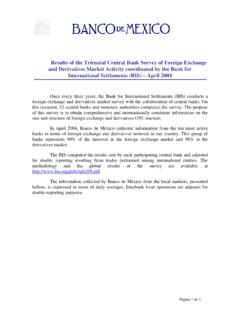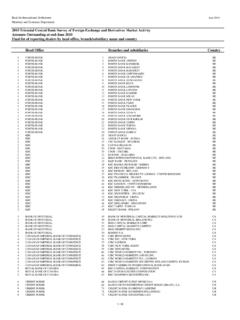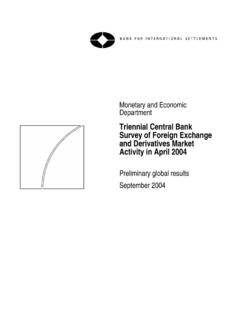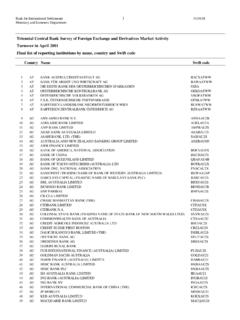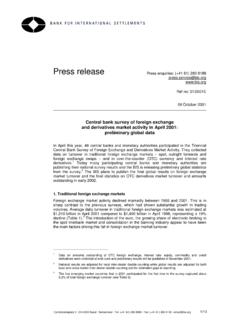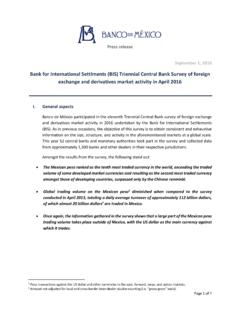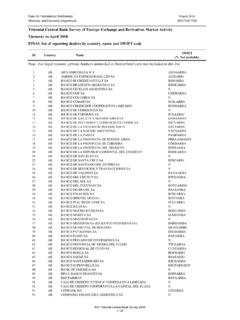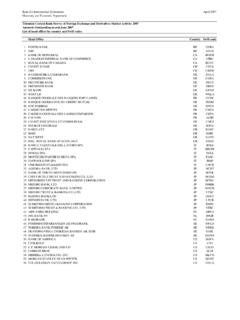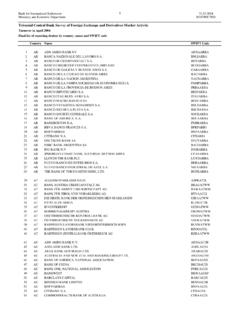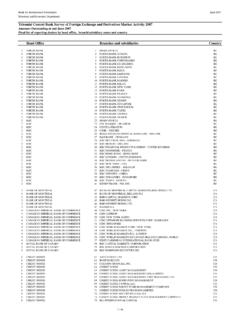Transcription of Turnover in foreign exchange and derivatives markets, 2016 ...
1 Press release Page 1/4 Embargo: 1 September 2016, pm (CEST) Communications Box, CH-8022 Zurich Telephone +41 58 631 00 00 Zurich, 1 September 2016 Turnover in foreign exchange and derivatives markets, 2016 BIS triennial survey : Results for Switzerland This press release presents the results for a Swiss National bank (SNB) survey on turnover1 in foreign exchange and derivatives markets. The request for data was sent to 30 banks that operate in Switzerland and have a sizeable share in the foreign exchange and over-the-counter (OTC) derivatives markets. These banks reported the Turnover of their domestic offices.
2 The survey is part of a global survey coordinated by the bank for International Settlements (BIS) on foreign exchange and derivatives market activity. It is conducted every three years and in over 50 countries. This is the tenth time that the SNB has taken part. The survey consists of two parts, with the first on Turnover (reference month: April 2016) and the second on amounts outstanding of contracts and on replacement values (reference date: 30 June 2016). The results of the first part of the survey pertaining to Switzerland are presented in this press release. Simultaneously, the BIS is presenting the global results of the survey on Turnover in the global foreign exchange and derivatives markets.
3 It also plans to publish the global results of the second part of the survey in the fourth quarter of 2016. 1 Turnover is defined as the contract volume (notional value) of all new trades concluded during the reporting period. Further details regarding the survey approach are available at , Statistics, Surveys, survey documents, OTC derivatives Statistics (BIS). Zurich, 1 September 2016 Press release Page 2/4 Summary of results On each of the trading days in April 2016, the 30 reporting banks recorded an average Turnover of USD 156 billion in foreign exchange transactions and USD 8 billion in interest rate derivatives Compared with the previous survey in 2013, the trading volume in foreign exchange transactions decreased by USD 60 billion (28%), and in interest rate derivatives by USD 24 billion (75%).
4 Regarding foreign exchange transactions, all instruments recorded a decline compared to 2013. Although fewer foreign exchange swaps and spot transactions, in particular, were concluded, they still remained proportionately the two most important instruments. Once again, the most frequently traded currency was the US dollar. At the same time, the Swiss franc replaced the euro as the second most important currency in foreign exchange transactions. Turnover in interest rate derivatives was again dominated by swaps and forward rate agreements; however, the Turnover for both was considerably below the values recorded for the previous survey in 2013.
5 Trading in interest rate derivatives denominated in euros receded in particular. As a result, the Swiss franc became the most important currency in interest rate derivatives trading for the first time since the 1998 survey . Turnover in foreign exchange transactions In April 2016, average daily Turnover in foreign exchange transactions amounted to USD 156 billion, which was 28% lower than in April 2013. With a share of 74%, foreign exchange swaps remained the most important instrument, followed by spot transactions with a share of 16%. Once again, almost two-thirds of foreign exchange transactions were settled via electronic trading platforms and the remainder by telephone.
6 Instruments Average daily Turnover in foreign exchange swaps fell by 12% to USD 116 billion from USD 132 billion in 2013. Turnover in spot transactions saw a considerable decline of 60% to USD 25 billion (2013: USD 63 billion). Outright forwards and foreign exchange options retained their relatively minor position, with USD 8 billion and USD 6 billion respectively. Currency swaps were barely used any more. 2 Besides spot transactions, foreign exchange transactions refer to foreign exchange swaps, outright forwards, foreign exchange options and currency swaps. Interest rate derivatives comprise swaps, forward rate agreements and options.
7 Zurich, 1 September 2016 Press release Page 3/4 Counterparties The banks main trading partners in the foreign exchange markets continued to be cross-border financial institutions, accounting for 69%, or USD 108 billion, of average daily Turnover . These were followed by local financial institutions, at 19%, or USD 30 billion. Overall, the share of financial institutions declined slightly to 88% (2013: 93%). Accordingly, the share of non-financial institutions rose from 7% to 12%. Compared with 2013, the prime brokerage share of total foreign exchange Turnover went up from 2% to 4%, while the share of retail-driven transactions remained almost unchanged at 10% (2013: 11%).
8 Currencies The decline in foreign exchange transactions primarily occurred in trades denominated in US dollars and euros. Despite this development, the US dollar remained the most traded currency. The euro, however, lost its position as the second most important currency in foreign exchange transactions to the Swiss franc. Regarding Turnover in currency pairs, the share of contracts in USD/CHF went up to 28%, from 21% in 2013, whereas the share of EUR/USD contracts declined from 32% to 23%. Other major currency pairs were USD/JPY (10%), EUR/CHF (7%) and GBP/USD (5%). Turnover in interest rate derivatives transactions Average daily Turnover in interest rate derivatives transactions amounted to USD 8 billion in April 2016, which was USD 24 billion or 75% lower than in April 2013.
9 Instruments Trades in swaps and forward rate agreements both recorded a considerable decline in Turnover . Compared with the previous survey in 2013, Turnover in swaps went down by 67% or USD 13 billion, and in forward rate agreements the drop was 86% or USD 12 billion. With a share of 76% (2013: 58%), swaps remained the most important instrument in interest rate derivatives transactions, followed by forward rate agreements with 23% (2013: 42%). Options continued to have limited importance, with a share of 2%. Counterparties The whole of the decrease in interest rate derivatives Turnover was accounted for by transactions with financial institutions abroad.
10 These declined by USD 26 billion, and as a result their share fell to 66% (2013: 96%). Correspondingly, the share of domestic financial institutions rose from 1% in 2013 to 16% in 2016, for non-financial institutions it went up from 3% to 18%. Zurich, 1 September 2016 Press release Page 4/4 Currencies While the majority of interest rate derivatives transactions an overall share of 94% were conducted in euros, US dollars and Swiss francs, Turnover in what had previously been the most important currency, the euro, plummeted by 91% or USD 22 billion. The share of transactions in euros thus decreased to 27%, compared to 74% in 2013.


